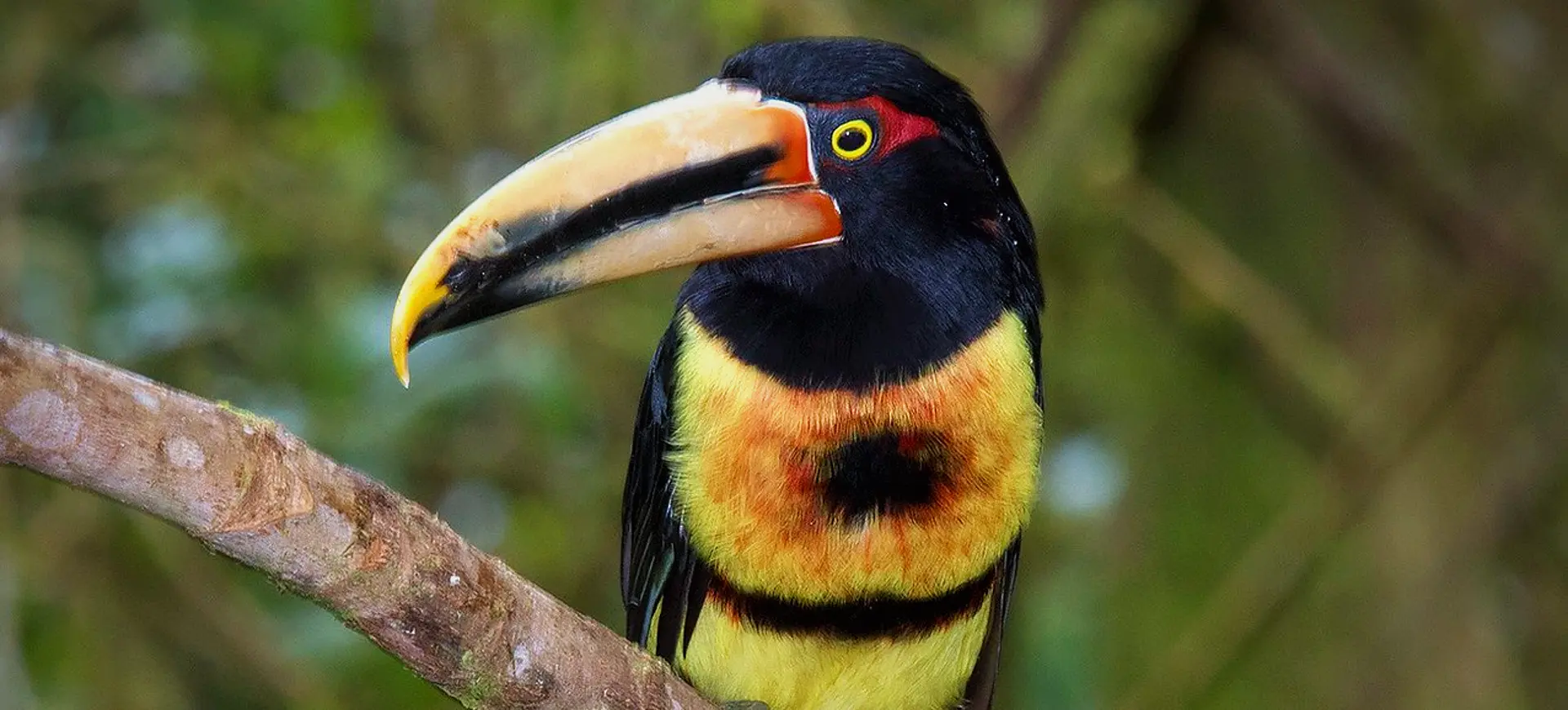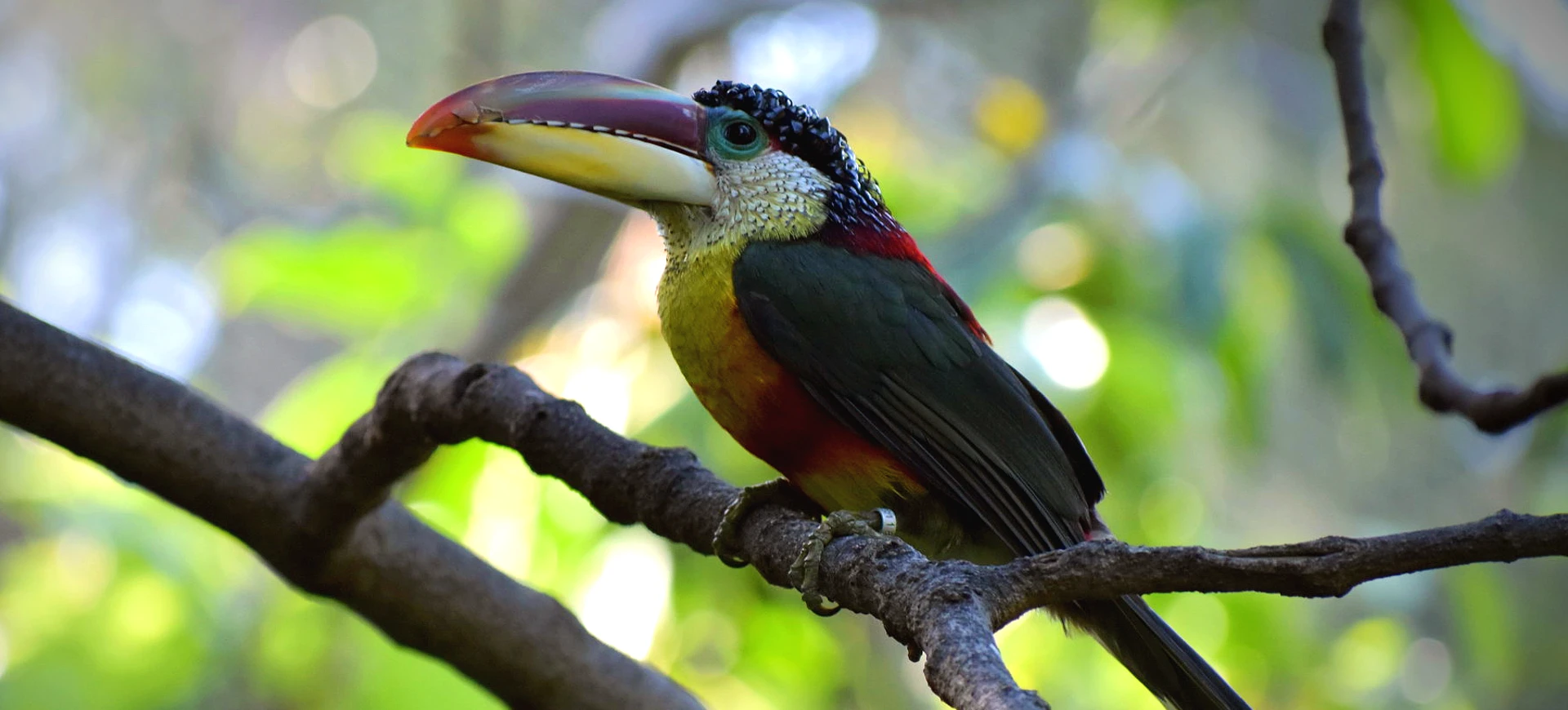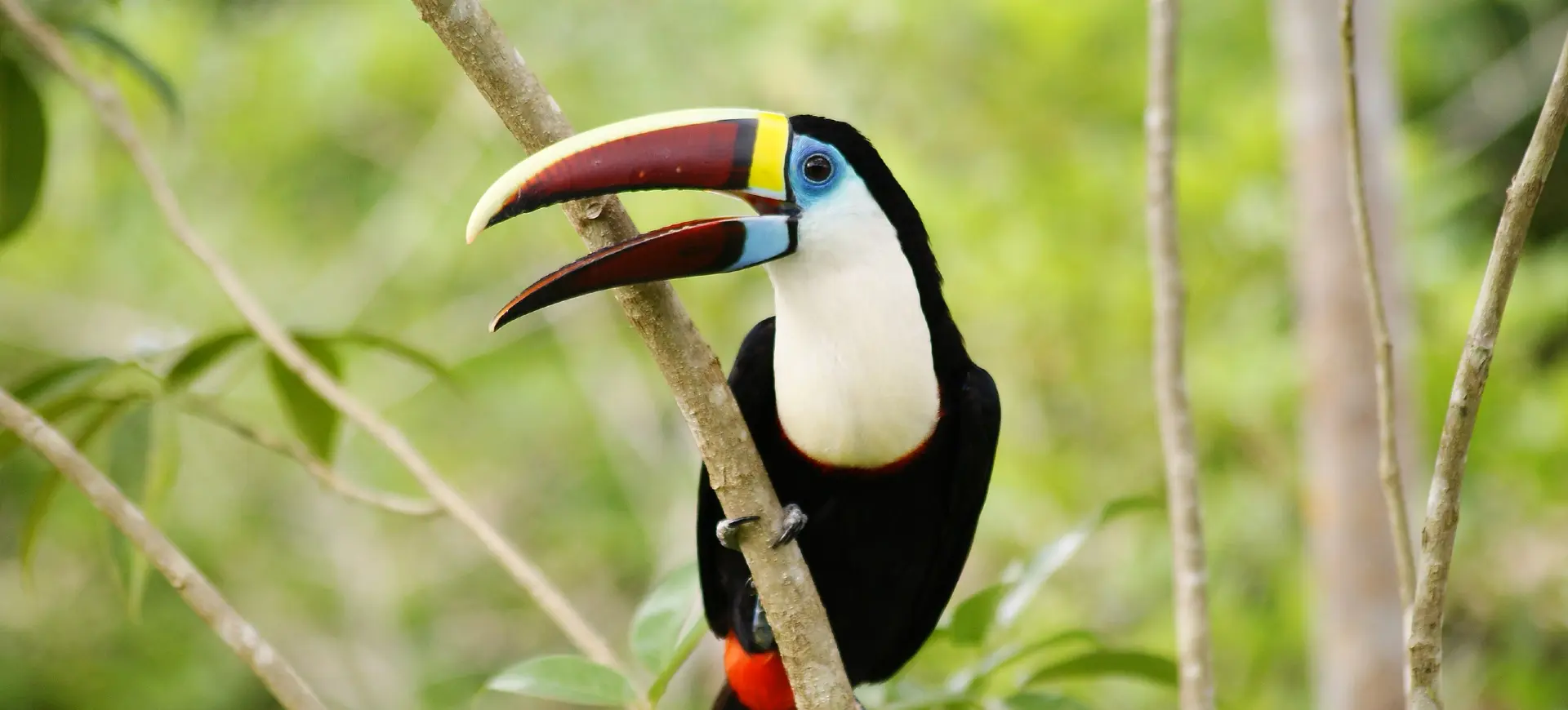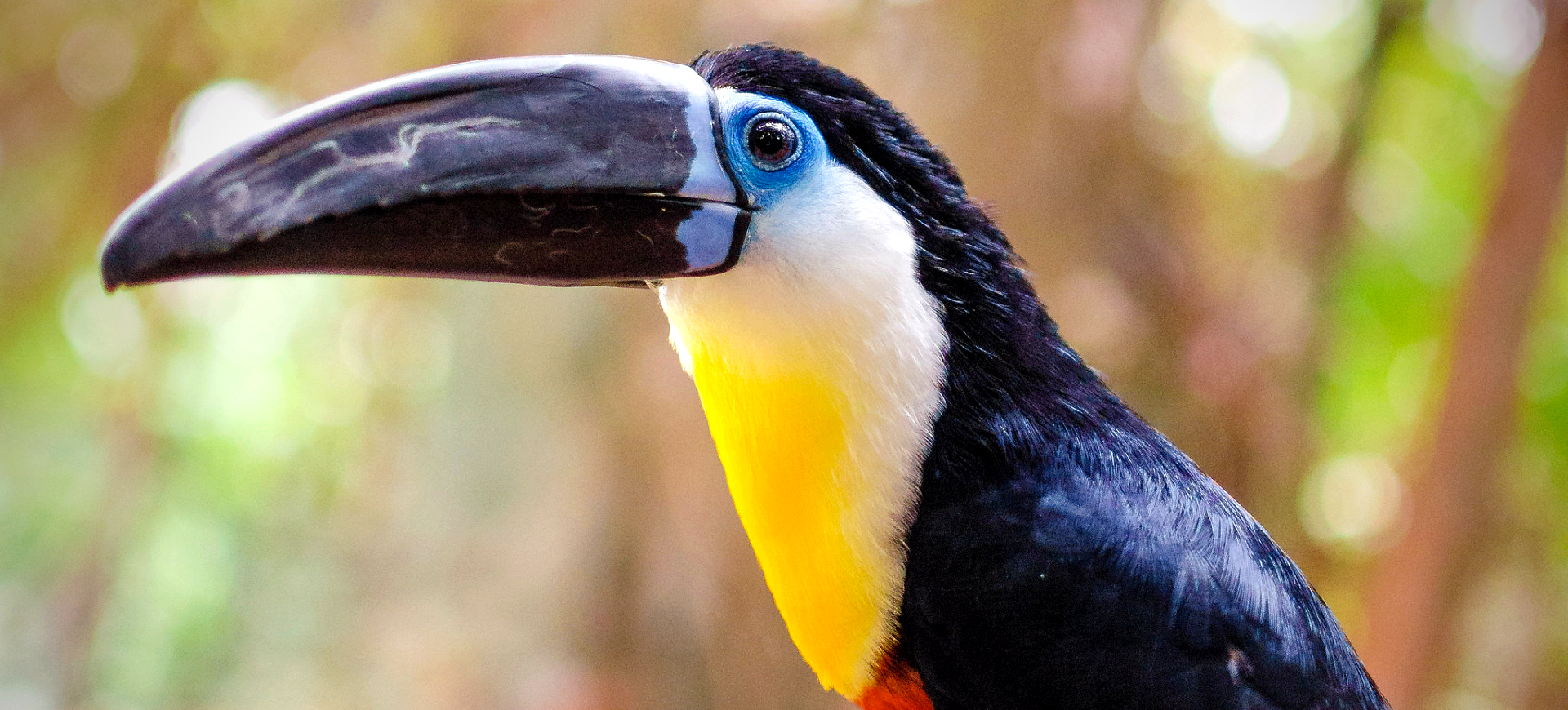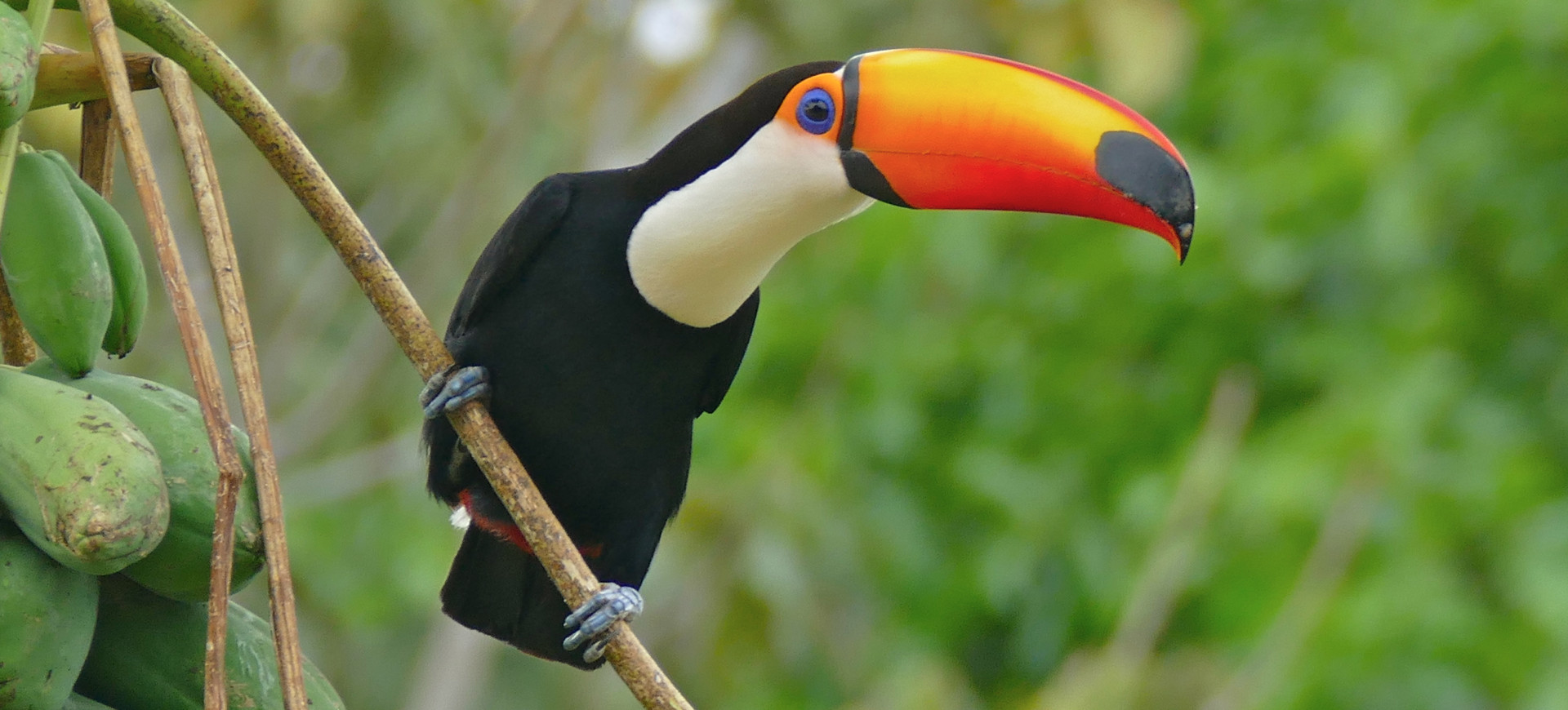Overview
The Guianan Toucanet (Selenidera piperivora) is a captivating bird species that belongs to the Ramphastidae family, known for its striking appearance and distinctive beak. This species is primarily found in the northern regions of South America, with its range extending across the Guianas, Venezuela, and parts of the northern Amazon Basin. The Guianan Toucanet is recognized for its vibrant plumage and the remarkable sexual dimorphism it exhibits, making males and females easily distinguishable.
Males typically showcase a black head and chest, with a unique combination of green, red, and yellow on their bodies. At the same time, females display a more subdued palette with a brownish head and chest, complemented by greenbacks and yellow underparts. Both genders possess a large, curved bill that is primarily yellow with a black tip, serving as a tool for feeding on fruits, insects, and occasionally small vertebrates. The Guianan Toucanet’s diet contributes to seed dispersal, playing a crucial role in their ecosystem.
These birds prefer dense, humid forests, particularly thriving in the canopy layer, where they can be found alone or in small groups. Their breeding habits include nesting in tree cavities and laying 2-4 eggs that both parents incubate and care for. Despite facing threats from habitat destruction and the pet trade, the Guianan Toucanet maintains a stable population in well-preserved areas, highlighting the importance of conservation efforts in protecting this and other species within the Amazonian biodiversity hotspot.
Taxonomy
Kingdom
Phylum
Class
Order
Family
Genus
Species
Type
Physical Description:
The Guianan Toucanet boasts a unique physical appearance characterized by its vibrant plumage and disproportionately large, colorful bill. The males typically exhibit a bright yellow throat and chest, contrasted with a green back, wings, and tail, while females display a more subdued coloration with varying shades of green and chestnut. Both sexes have striking blue skin around their eyes, adding to their distinctive look. The bill, although large, is surprisingly lightweight due to its porous structure, enabling the bird to forage without being weighed down.
In terms of size, the Guianan Toucanet is considered one of the smaller members of the toucan family. Despite their compact size, their long bills and bright colors make them easily identifiable. These birds are adept climbers, using their strong legs and toes to maneuver through the dense foliage of their rainforest habitats. The Guianan Toucanet’s physical attributes, including its bill, are not just for show but play crucial roles in feeding, from reaching fruits on thin branches to extracting insects from crevices.

Lifespan: Wild: ~10 Years || Captivity: ~20 Years

Weight: Male: 4.6-5.6 ounces (129-159 g) || Female: 4.7-5.8 ounces (132-165 g)

Length: Male & Female: 13-14 inches (33-36 cm)

Top Speed: 40 mph (64 km/h)
Characteristic:
Native Habitat:
The Guianan Toucanet is native to the northeastern regions of South America, with its range extending across several countries, including Guyana, Suriname, French Guiana, and northern parts of Brazil. This bird favors tropical rainforests’ dense, humid environments, mostly in the canopy layer. The complexity of these habitats provides ample food sources and nesting sites, which are critical for their survival and reproduction. Adapted to life in the high trees, the Guianan Toucanet is rarely seen on the ground, preferring the safety and resources available above.
Their habitat preferences include primary and secondary rainforests, indicating their adaptability to different stages of forest regeneration. However, they are most commonly found in areas with abundant fruiting trees, which are essential for their diet. The Guianan Toucanet’s reliance on specific habitat conditions makes them vulnerable to deforestation and habitat fragmentation, which are ongoing concerns in their native regions. Despite these challenges, their wide distribution helps buffer some of the impacts of habitat loss.
Climate Zones:
Biomes:
WWF Biomes:
Biogeographical Realms:
Continents:
Diet:
Diet & Feeding Habits:
The diet of the Guianan Toucanet is predominantly frugivorous, relying heavily on various fruits found within its habitat. This preference for fruit makes them important seed dispersers, playing a vital role in the health and regeneration of their rainforest environments. In addition to fruit, they occasionally consume insects, small reptiles, and bird eggs, showcasing their opportunistic feeding behavior. This varied diet allows them to exploit different food sources throughout the year, adapting to seasonal changes in food availability.
Feeding primarily in the canopy, the Guianan Toucanet utilizes its long bill to reach fruit on thin branches inaccessible to birds with shorter bills. They are also known to participate in “fruit tossing,” where they throw fruits into the air and catch them in their bills, a technique that may help consume larger or awkwardly shaped fruits. The social nature of these birds often leads to communal feeding sessions, where groups congregate in fruiting trees, sharing the bounty. Despite their diet, water intake is also crucial, and they are frequently seen drinking from rainforest pools or during rainfall.
Mating Behavior:
Mating Description:
The mating behavior of the Guianan Toucanet involves a combination of visual displays and vocalizations, with males often seen performing for potential mates. These displays include bill-fencing and fruit-passing rituals, which help strengthen pair bonds and demonstrate the male’s ability to provide food. Nesting occurs in tree cavities, where the female lays a clutch of two to four eggs. Both parents participate in incubating and rearing the young, showcasing a high degree of parental investment.
Once hatched, the chicks are altricial, meaning they are born blind and featherless, completely dependent on their parents for food and protection. The parents feed them a regurgitated mixture of fruit and small prey, ensuring rapid growth. This cooperative breeding strategy enhances the survival rate of the offspring, allowing them to reach fledging age with a better chance of survival. The bonding between mating pairs is strong, with some pairs remaining together across breeding seasons, although not much is known about long-term monogamy in this species.
Reproduction Season:
Birth Type:
Pregnancy Duration:
Female Name:
Male Name:
Baby Name:
Social Structure Description:
The Guianan Toucanet exhibits a complex social structure characterized by solitary and group behaviors. Outside the breeding season, these birds can be seen foraging in small groups or pairs, indicating social interaction and cooperation. These groupings may help in locating food sources and providing protection against predators. During the breeding season, however, pairs become more territorial, defending their nesting sites from other toucanets and potential threats.
The strong pair bond observed in Guianan Toucanets suggests a high level of cooperation between mates, especially in raising their young. This cooperative breeding strategy enhances the chances of offspring survival, with both parents involved in feeding and protecting the chicks. Social hierarchies within groups are poorly understood, but individual interactions suggest complex relationships. Understanding the social dynamics of these birds is crucial for conservation efforts, as it impacts their breeding success and habitat use.
Groups:
Conservation Status:
Population Trend:
The Guianan Toucanet is considered to have a stable population across its native range, with no immediate threats leading to a rapid decline in numbers. This stability is attributed to the species’ adaptability to varying forest conditions and ability to inhabit primary and secondary forests. However, localized threats such as habitat loss due to deforestation and illegal pet trade can impact specific populations, leading to fragmented habitats and reduced genetic diversity.
Conservation efforts focusing on habitat preservation and anti-poaching laws are vital for maintaining population stability. Protected areas and national parks play a crucial role in providing safe havens for these birds, away from the impacts of human activity. Research and monitoring programs help understand population dynamics and the effectiveness of conservation strategies, ensuring adaptive management practices can be implemented as needed. Community involvement and education are also key in conservation, promoting sustainable practices and reducing human-induced pressures on toucanet populations.
Population Threats:
The primary threat facing the Guianan Toucanet is habitat destruction due to logging, agriculture, and urban expansion. These activities lead to the fragmentation of their rainforest habitat, isolating populations and reducing available resources. Illegal pet trade is another significant threat, with the species’ striking appearance making it a target for poachers. Removing individuals from the wild for the pet trade reduces wild populations and disrupts social structures and breeding systems.
Climate change poses a long-term threat, potentially altering the distribution of fruit trees and impacting food availability. Pesticide use in agricultural areas adjacent to their habitat can also affect food sources, posing a risk to their health and prey availability. Conservation strategies must address these threats through habitat protection, legal protection against poaching, and sustainable land-use practices. Engaging local communities in conservation efforts is crucial for reducing the impact of human activities on the Guianan Toucanet and its habitat.
Conservation Efforts:
Conservation efforts for the Guianan Toucanet include establishing protected areas and national parks within its range, which help preserve critical habitat and provide a refuge from human disturbances. International and local conservation organizations are working to implement sustainable land management practices, aiming to reduce habitat destruction and fragmentation. Education and awareness programs are crucial in reducing the demand for toucanets in the illegal pet trade, highlighting the importance of keeping these birds in the wild.
Research and monitoring are key components of conservation strategies, providing data on population trends, habitat use, and threats. This information is vital for adaptive management and developing targeted conservation actions. Community involvement in conservation efforts helps ensure the sustainability of these actions, with local populations playing a critical role in protecting the Guianan Toucanet and its habitat. Conservation success depends on a collaborative approach, combining legal protection, habitat management, research, and community engagement.
Additional Resources:
Fun Facts
- The Guianan Toucanet’s bill is not just for show; it serves as a tool for feeding, reaching fruits, and thermal regulation.
- Despite their bright colors, these birds can blend into the canopy, thanks to their greenbacks, which camouflage them against the leaves.
- They are capable of “fruit tossing,” a unique feeding behavior where they throw fruits into the air and catch them in their bills.
- Guianan Toucanets play a critical role in their ecosystem as seed dispersers, aiding the growth of new plants and trees.
- Their vocalizations are distinctive and can carry over long distances, serving as a means of communication within the dense forests.
- The female toucanet excavates the nest cavity in tree trunks, where she will lay her eggs.
- They have a zygodactyl foot structure, with two toes facing forward and two backward, which helps them grip branches securely.
- Guianan Toucanets are monogamous, often forming long-term pair bonds with their mates.
- The blue skin around their eyes is not only striking but also serves as a distinguishing feature among toucan species.
- Despite their small size, toucanets can consume large fruits whole, using their large bills to manipulate and consume them efficiently.





